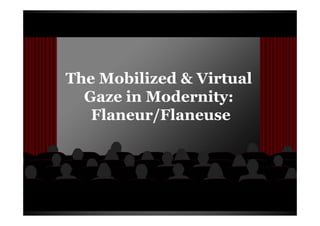
The mobilized virtual gaze
- 1. The Mobilized & Virtual Gaze in Modernity: Flaneur/Flaneuse
- 2. 1. 1 About the Author 2. Some of the terms 3. Panorama & Diorama vs Panoptica p 4. Where to now?
- 3. Who is Anne Friedberg? 1952 -2009 A historian and theorist of modern media culture, interests include film and media histories and theories theories, visual culture and early cinema, theories of vision and visuality, architecture and fil global media hit t d film, l b l di culture. Major Works • Close-Up 1927-1933: Cinema and Modernism, co-edited by Anne Friedberg, James Donald and Laura Marcus (Princeton University Press, 1998) Press • Window Shopping: Cinema and the Postmodern, by Anne Friedberg (University of California Press, 1993) • Th Vi The Virtual Wi d l Window: From Alb i to Mi F Alberti Microsoft, b A f by Anne F i db Friedberg (Th MIT (The Press, 2006)
- 4. Some of the terms • Modernity: a social formation coincident with late 18th and early 19th century y 9 y industrialisation and urbanisation • Gaze: Mobilized and virtual visuality • Mobilized & Virtual Gaze: Spacial and temporal mobility
- 5. Flaneur & Flaneuse Flaneur wandered the streets in modern times observing but not p g participating p g Flaneuse i the f Fl is h female equivalent b did not l i l but really have a place until the development of the cinema & ultimately the shopping mall
- 6. Panoptica & the cinema • Panoptic model was used as an explanation in the development of the p p cinema, due to: - film spectator being totally invisible - the cinema is in an enclosed space However… the th panoptic model d ti d l does not explore th t l the subjectivity of the observer
- 7. The Panorama
- 9. The diorama
- 11. Where does this lead us to? • In cinematic times – the viewer remained immobile in front of the screen, now we , have “new forms of ever-virtual mobility” • Multi screen “windows” Multi-screen windows • Window shopping & windows shopping converge
- 12. References • Cl Close-Up 1927-1933: Ci U Cinema and d Modernism, co-edited by Anne Friedberg, James Donald and Laura M J D ld d L Marcus (P i (Princeton t University Press, 1998) • Window Shopping: Cinema and the i d h i i d h Postmodern, by Anne Friedberg (University of C lif f California P i Press, 1993) ) • The Virtual Window: From Alberti to Microsoft, by Anne Friedberg (The MIT Press, 2006)